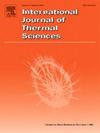New model for heat transfer of copper roller in twin-roll strip casting to assist experimental and industrial process
IF 4.9
2区 工程技术
Q1 ENGINEERING, MECHANICAL
International Journal of Thermal Sciences
Pub Date : 2025-02-27
DOI:10.1016/j.ijthermalsci.2025.109826
引用次数: 0
Abstract
In this study, a one-dimensional heat transfer model of the casting roller is developed to investigate the heat transfer behavior during twin-roll strip casting of aluminum alloy. A small copper block is used as the computational domain to simulate the periodic heat transfer characteristics as the roller rotates, with boundary conditions adjusted to reflect the contact with molten metal and cooling water. The heat flux and heat transfer coefficients are determined through experiments and theoretical calculations. The model has been validated through a series of experiments, showing good agreement with measured values. Results from the numerical simulations revealed the temperature, stress, and displacement fields of the roller during casting cycles, providing insight into the roller's thermal fatigue and long-term stability. The findings suggest that appropriate cooling water flowrates enhance the roller's cooling efficiency, stabilize temperature variations, and reduce thermal fatigue. Study has shown that by increasing the water flowrate from 40 m3/h to 50 m3/h, the cycle life of the roller can be increased by 4941 h. The model provides a reliable tool for optimizing the cooling parameters and predicting the usage and the operational life of casting roller in industrial applications.
求助全文
约1分钟内获得全文
求助全文
来源期刊

International Journal of Thermal Sciences
工程技术-工程:机械
CiteScore
8.10
自引率
11.10%
发文量
531
审稿时长
55 days
期刊介绍:
The International Journal of Thermal Sciences is a journal devoted to the publication of fundamental studies on the physics of transfer processes in general, with an emphasis on thermal aspects and also applied research on various processes, energy systems and the environment. Articles are published in English and French, and are subject to peer review.
The fundamental subjects considered within the scope of the journal are:
* Heat and relevant mass transfer at all scales (nano, micro and macro) and in all types of material (heterogeneous, composites, biological,...) and fluid flow
* Forced, natural or mixed convection in reactive or non-reactive media
* Single or multi–phase fluid flow with or without phase change
* Near–and far–field radiative heat transfer
* Combined modes of heat transfer in complex systems (for example, plasmas, biological, geological,...)
* Multiscale modelling
The applied research topics include:
* Heat exchangers, heat pipes, cooling processes
* Transport phenomena taking place in industrial processes (chemical, food and agricultural, metallurgical, space and aeronautical, automobile industries)
* Nano–and micro–technology for energy, space, biosystems and devices
* Heat transport analysis in advanced systems
* Impact of energy–related processes on environment, and emerging energy systems
The study of thermophysical properties of materials and fluids, thermal measurement techniques, inverse methods, and the developments of experimental methods are within the scope of the International Journal of Thermal Sciences which also covers the modelling, and numerical methods applied to thermal transfer.
 求助内容:
求助内容: 应助结果提醒方式:
应助结果提醒方式:


